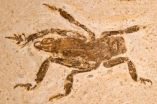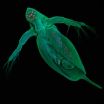(Press-News.org) Conservationists across the United States are racing to discover a solution to White-Nose Syndrome, a disease that is threatening to wipe out bat species across North America. A review published in Conservation Biology reveals that although WNS has already killed one million bats, there are critical knowledge gaps preventing researchers from combating the disease.
WNS is a fatal disease that targets hibernating bats and is believed to be caused by a newly discovered cold-adapted fungus, Geomyces destructans, which infects and invades the living skin of hibernating bats. Since 2006 about one million bats across six species in eastern North America have died from WNS, and as a result several species of bats face endangerment or extinction.
"White-Nose Syndrome was first documented in 2006 in a tourist cave near Albany, New York. Dead and dying bats were then found in four nearby caves, 30 km west of Albany," said lead author Janet Foley from the University of California, Davis. "By July 2010 G.destructans was identified in hibernating bats in 13 states as well as in Ontario and Quebec across the Canadian Border."
Affected bat species include the endangered Indiana and gray bats (Myotis sodalis and M. grisescens), little brown bat (M. lucifugus) and the cave bat (M. velifer). Infection has also been confirmed in five species of bats in Europe, although no similar epidemic has yet been recorded.
The low temperatures and humid conditions of bat caves create ideal breeding grounds for this fungus, and in some bat colonies the mortality rate from WNS has been more than 95%.
"Some bats in infected bat colonies behave abnormally when infected, choosing to hibernate in exposed places, such as cave entrances or even flying during the day," said Foley. "Bats regularly arouse from hibernation in order to drink, urinate and relocate. This causes them to burn up their only source of energy during winter, the body fats they stored prior to winter when insect prey was still available. Fungal infection might be leading to more frequent arousals from hibernation, causing infected bats to use up their fat reserves earlier, with potentially fatal consequences."
Although the effects of the disease are all too apparent, there are critical knowledge gaps for researchers confronted with combating the disease.
It remains unclear if G. destructans is the only pathogen involved, how it causes mortality, and its means of transmission. Some evidence suggests that people can move the fungus from cave to cave.
"Our study considers how epidemiology and disease ecology can help fill these knowledge gaps," said Foley. "We believe that a roadmap including bat monitoring and disease surveillance, coupled with active research into finding ways to treat individual bats will be vital to combating this disease."
"Based on current data, we believe that the culling of bats would be both premature and ill-advised. Instead we see efforts to conserve the genetic diversity of bat populations, combined with a program of educating the public to be key parts of the roadmap."
Dr Foley's team includes bat and disease ecologists from three different public agencies and academia and tries to make the point that creative, scientifically-sound ideas will be key to the success of any management plans.
The group outlines an outbreak investigation framework that includes establishment of diagnostic standards, case definitions, and gathering of information on potential treatments for similar diseases.
The importance of monitoring bat population health is also stressed, as is improving public education and awareness of the disease, especially as many species of bats live in caves popular among tourists. If current declines in bat populations continue, the researchers expect strong reductions in the ability of bats to reduce insect pests and play important ecological roles in unique cave ecosystems.
The team also called for further studies of the chemical or biological agents that can kill the fungus, but have yet to be proven safe for bats.
"In the three years since its discovery WNS has changed the focus of bat conservation in North America," concluded Foley. "A national response is required and our epidemiological roadmap is designed to help inform state and national efforts to combat WNS across North America."
INFORMATION: END
Using a generic drug to treat hypertension and heart failure, instead of branded medicines from the same class, could save the UK National Health Service (NHS) at least £200 million in 2011 without any real reduction in clinical benefits.
That is the key finding of a systematic review, statistical meta-analysis and cost-effectiveness analysis just published online by IJCP, the International Journal of Clinical Practice.
Researchers from University College London Hospitals NHS Foundation Trust looked at 14 hypertension and heart studies published between 1998 and 2009 ...
The genes that make up the human genome were mapped by HUGO, the Human Genome Organisation, and published in 2001. Now the project is expanding into the HUPO, the Human Proteome Organisation. Within the framework of this organisation, many hundreds of researchers around the world will work together to identify the proteins that the different genes give rise to in the human body.
"The 'proteome', the set of all human proteins, is significantly more complicated than the genome. There are over 20 000 proteins coded by the genome in the human body and each protein can have ...
Up to seven per cent biodiesel blended in regular diesel will presumably not cause greater health risks for the population than the use of pure fossil diesel. This is the main conclusion in a memorandum from the Norwegian Institute of Public Health and the Climate and Pollution Control Agency (formerly SFT) to the Ministry of Health and Care Services and the Ministry of the Environment in Norway.
"A higher content of biodiesel (up to 20 per cent) requires more research to assess health effects. This must include different types of biofuels and blending ratios, as well ...
University of Manchester scientists have shown that a protein involved in blood clotting can be used to diagnose and subsequently monitor the treatment of a group of childhood genetic diseases.
In the study, published in the Journal of Inherited Metabolic Disease, the researchers were able to show that the clotting agent, heparan cofactor II/Thrombin (HCII/T) complex, could be used as a 'biomarker', or biological tell, in individuals with mucopolysaccharide (MPS) diseases.
MPS diseases are severe metabolic conditions caused by a genetic defect that affects the body's ...
University of Granada scientists have been the first to analyze the relation between drug abuse and recognition of basic emotions (happiness, surprise, wrath, fear, sadness and disgust) by drug-abusers. Thus, the study revealed that drug-abusers have difficulty to identify negative emotions by their facial expression: wrath, disgust, fear and sadness.
Further, regular abuse of alcohol, cannabis and cocaine usually affects abusers' fluency and decision-making. Consuming cannabis and cocaine negatively affects work memory and reasoning. Similarly, cocaine abuse is associated ...
Pacific Northwest farmers could someday be filling up their machinery's tanks with fuels produced from their own fields, according to ongoing research by U.S. Department of Agriculture (USDA) scientists.
Since 2003, Agricultural Research Service (ARS) microbiologist Hal Collins and agronomist Rick Boydston have been studying safflower, camelina, soybeans, mustard, canola, wheat, corn and switchgrass to assess their potential for bioenergy production. ARS is USDA's chief intramural scientific research agency, and this research supports the USDA priority of developing ...
Moving to a new country is difficult—learning the cultural rules and meanings of your new home is especially challenging. A new study published in Psychological Science, a journal of the Association for Psychological Science, finds that this process is easier for children, but quickly becomes more difficult after about the age of 15.
Psychological scientists have found that many aspects of learning and development have a critical window—if a developmental event doesn't happen by a particular age, it never will. For example, learning perfect pitch or learning to see with ...
Camden, N.J., February 3, 2011– Studies show drinking V8® 100% vegetable juice may be a simple way for people to increase their vegetable intake and may help them manage their weight – two areas of concern outlined in the newly released 2010 U.S. Dietary Guidelines for Americans.1
A study conducted by researchers at the University of California-Davis found that adults who drank one, 8-ounce glass of vegetable juice each day, as part of a calorie-appropriate Dietary Approaches to Stop Hypertension (DASH) diet, got nearly twice as many vegetable servings a day than those ...
CHAMPAIGN, Ill. — Researchers have discovered the 100 million-year-old ancestor of a group of large, carnivorous, cricket-like insects that still live today in southern Asia, northern Indochina and Africa. The new find, in a limestone fossil bed in northeastern Brazil, corrects the mistaken classification of another fossil of this type and reveals that the genus has undergone very little evolutionary change since the Early Cretaceous Period, a time of dinosaurs just before the breakup of the supercontinent Gondwana.
The findings are described in a paper in the open access ...
MBL, WOODS HOLE, MA—The ubiquitous freshwater "water flea," Daphnia pulex, may be too small to see, but it has amply proven its value as an "sentinel species" for the presence of toxins and pollutants in the environment.
Daphnia's response to exposure to toxic metals and other chemical pollutants is well studied, and this information is routinely used by groups such as the US Environmental Protection Agency (EPA) to define regulatory limits, and to monitor industrial and municipal discharges.
This week, Daphnia pulex is receiving an enormous pat on the back from the ...

